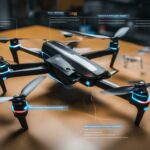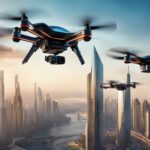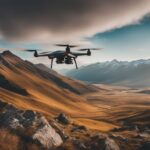How do drones work? Have you ever wondered? These remarkable devices have become an integral part of our lives, serving various purposes such as aerial photography, delivery services, and agricultural monitoring. But what exactly goes into their operation?
Well, drones, also known as Unmanned Aerial Vehicles (UAVs), are aircraft controlled remotely, either by a person using a hand-held transmitter or through autonomous software-controlled flight plans. They consist of essential components such as power sources, motors, propellers, and a controller.
The lift is generated by the propellers, which work similarly to helicopter blades. Most drones are quadcopters with four propellers that offer stability during flight. By adjusting the speed of the motors, drones can move in different directions. Many drones feature cameras attached to gimbals, ensuring high-quality images and videos.
With autonomous flight capabilities, these devices can follow pre-programmed paths and even avoid obstacles, showcasing the seamless blend of engineering and technology behind their functionality. Understanding how drones work enhances our appreciation for these devices and opens up a world of possibilities for their future applications.
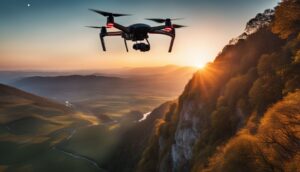
Understanding Aerial Technology: What is a Drone and How Do Drones Work?
Drones, also known as Unmanned Aerial Vehicles (UAVs), are aircraft that can fly without an onboard human pilot. They are controlled remotely, usually by a person using a hand-held transmitter or through autonomous software-controlled flight plans in their embedded systems working in conjunction with GPS.
These fascinating devices have become a significant part of our lives, with various applications ranging from aerial photography to delivery services and agricultural monitoring. Understanding how drones work can provide a deeper appreciation for the technology and its potential uses.
Definition of a drone
A drone, or UAV, is an aircraft that can operate without an onboard human pilot. It is able to fly and perform various tasks through remote control operation or autonomous flight capabilities. Drones come in different sizes and shapes, depending on their specific use and requirements.
Unmanned Aerial Vehicles (UAVs)
Drones are commonly referred to as Unmanned Aerial Vehicles (UAVs) due to their ability to operate without a human pilot on board. This feature allows for increased flexibility and versatility in various industries and applications.
Remote control operation
Most drones can be controlled remotely by a person using a hand-held transmitter. This transmitter sends signals to the drone, commanding it to perform specific actions such as taking off, landing, or changing its flight path. The pilot can control the drone’s movement, altitude, and various other parameters through the transmitter.
Autonomous flight capabilities
In addition to remote control operation, many modern drones are equipped with autonomous flight capabilities. These drones can navigate and fly without direct human intervention. Autonomous flight is achieved through embedded software-controlled flight plans and the use of GPS technology. This enables the drone to follow pre-programmed flight paths, return to its launch point, and even avoid obstacles.
Structure and Components for Drones
Drones consist of various components that work together to enable flight and control. Understanding the structure and components of drones is crucial in comprehending how they operate and perform their specific tasks.
Power source
The power source of a drone is typically a battery or fuel, depending on the type and size of the drone. The power source provides the necessary energy for the motors and other electronic components to function during flight.
Motors
Drones are equipped with motors that generate the necessary thrust to move the drone through the air. These motors are responsible for spinning the propellers and creating the propulsion force needed for flight.
Propellers
Propellers are crucial components of a drone as they generate the lift required for flight. When the motors spin the propellers, air pressure decreases above the blades and increases beneath them, causing the drone to ascend. The design and configuration of the propellers can significantly affect the drone’s performance and stability during flight.
Controller Mechanics: Understanding How Drones Work
The controller is the heart of the drone and is responsible for receiving and interpreting commands from the pilot or autonomous flight software. It communicates with the drone through radio waves, typically in the 2.4 gigahertz spectrum. The controller allows the pilot to control the drone’s movement, altitude, and other parameters.
Lightweight and durable material
Drones are often constructed using lightweight yet durable materials such as carbon fiber, plastic, or aluminum. These materials help reduce the overall weight of the drone, making it more maneuverable and efficient during flight. The durability of the materials ensures that the drone can withstand flight conditions and potential impacts without compromising its performance or structural integrity.
Controller and Communication
The controller plays a vital role in operating a drone and maintaining communication between the pilot and the drone itself. Understanding how the controller works and the communication methods used is essential for effective drone operation.
Linking to a smartphone or tablet
Many drones can be linked to a smartphone or tablet, allowing for additional functionality and control options. By connecting the drone to a smartphone or tablet, the pilot can access real-time video feeds, adjust settings, and even program flight paths.
Radio waves communication
The controller communicates with the drone through radio waves, typically in the 2.4 gigahertz spectrum. These radio waves carry commands and instructions from the pilot to the drone, informing it of the desired actions and movements.
GPS technology for navigation
Some drones utilize GPS (Global Positioning System) technology for navigation and automatic return to a home point if the connection between the pilot and the drone is lost. GPS enables the drone to accurately determine its position, altitude, and direction, providing greater control and reliability during flight.
Propellers and Lift
Understanding how propellers generate lift is instrumental in comprehending how drones achieve and maintain flight. The principles behind propeller-driven lift are similar to those of helicopter blades.
Generation of lift
Propellers play a crucial role in generating the lift required for flight. When the motors spin the propellers, air pressure decreases above the blades and increases beneath them. This pressure difference creates an upward force, known as lift, which allows the drone to ascend and remain airborne.
Similarity to helicopter blades
Propellers on drones function similarly to helicopter blades. They create lift through the rotation and air displacement caused by their spinning motion. By adjusting the speed and pitch of the propellers, the pilot can control the amount of lift generated and the drone’s overall flight characteristics.
Air pressure differences
The air pressure differences created by the rotating propellers are essential for generating lift. As the propellers spin, they create a high-pressure zone beneath them and a low-pressure zone above them. This pressure difference results in an upward force that counteracts the weight of the drone, allowing it to achieve and maintain flight.
Ascending and descending
Controlling the propeller speed allows the pilot to control the drone’s ascent and descent. Increasing the propeller speed results in a higher lift force, causing the drone to ascend. Decreasing the propeller speed decreases the lift force, allowing gravity to pull the drone down and descend.
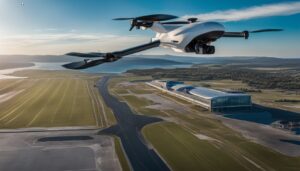
Quadcopter Configurations
The majority of consumer drones are quadcopters, meaning they have four propellers. The specific configuration of a quadcopter provides stability and maneuverability during flight.
Definition of a quadcopter
A quadcopter is a type of drone that employs four propellers to achieve flight. It is named so because it has four “copters” or propellers. The four-propeller configuration enhances stability and control during flight, making it widely used in consumer drones.
Balancing forces
The quadcopter configuration ensures that the forces acting on the drone are balanced, resulting in improved stability during flight. By having two propellers spinning in one direction (clockwise) and the other two spinning in the opposite direction (counter-clockwise), the quadcopter maintains stability and control.
Stability during flight
The quadcopter configuration provides inherent stability during flight by evenly distributing the lift and balancing the rotational forces generated by the propellers. This stability allows for smoother and more controlled maneuvers, making quadcopters popular among drone enthusiasts and professionals alike.
Movement and Control
Understanding the movement and control capabilities of a drone is essential for piloting and operating it effectively. Various factors, such as motor speed and propeller configuration, contribute to the drone’s ability to maneuver in different directions.
Adjusting motor speed
Controlling the speed of the motors is crucial in directing the drone’s movement. By adjusting the speed of individual motors, the pilot can manipulate the drone’s position, orientation, and overall movement.
Moving forward and backward
To move the drone forward, the back two motors spin faster than the front two. This differential in motor speed tilts the drone forward, generating forward thrust and causing it to move in that direction. Moving the drone backward follows a similar principle, with the front two motors spinning faster than the back two.
Moving left and right
To move the drone to the left, the motors on the right side spin faster than those on the left side. This difference in motor speed causes the drone to tilt to the left, resulting in lateral movement to the left. Moving the drone to the right is achieved by spinning the left side motors faster than the right side.
Ascending and descending
Ascending and descending are controlled by adjusting the speed of all four motors simultaneously. To make the drone ascend, all four motors increase their speed, creating additional lift force that allows the drone to rise vertically. Conversely, slowing down the motors decreases the lift force, causing the drone to descend.
Turning or yawing
Turns or yawing of the drone are accomplished by increasing the speed of the motors spinning in one direction and decreasing the speed of those spinning in the opposite direction. This differential in motor speed generates a rotation force, causing the drone to rotate around its central axis. Yawing is used to change the drone’s direction without changing its flight path.
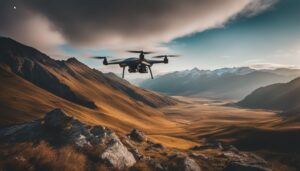
Camera and Gimbal Technology
Many drones are equipped with cameras, enabling various applications such as aerial photography and videography. The integration of cameras and gimbal technology further enhances the capabilities and quality of the drone’s imaging capabilities.
Inclusion of cameras
Most consumer drones now include cameras, allowing users to capture photos and videos from an aerial perspective. These cameras are typically mounted on the drone’s body and offer different resolutions and features depending on the specific drone model.
Aerial photography and videography
Drones equipped with cameras have revolutionized aerial photography and videography. They provide the ability to capture stunning images and footage from unique angles and perspectives. Aerial photographers and videographers can now easily capture breathtaking landscapes, events, and other subjects with ease and precision.
Gimbal support
Gimbals are pivoted supports that allow the rotation of an object, in this case, a camera, about a single axis. Many drones are equipped with gimbals to support the camera and stabilize it during flight. The gimbal compensates for the drone’s movement and vibrations, ensuring that the camera remains steady and produces high-quality images and videos.
Stabilizing the camera
Stabilizing the camera is crucial in achieving sharp and clear images while the drone is in motion. The integration of gimbals and advanced stabilization technologies allows for smooth and stable footage, even during fast maneuvers or windy conditions. This ensures that the aerial photography and videography captured by the drone are of professional quality.
Autonomous Flight
Modern drones often come with autonomous flight capabilities, which enable them to perform tasks without direct human intervention. Utilizing sensors and GPS technology, autonomous drones can navigate and perform various functions with high precision.
Integration of sensors and GPS
Autonomous drones are equipped with various sensors, such as accelerometers, gyroscopes, and altimeters. These sensors provide real-time data on the drone’s position, altitude, speed, and orientation. In combination with GPS technology, the drone can accurately determine its location and navigate accordingly.
Pre-programmed flight paths
Using autonomous flight software, pilots can pre-program specific flight paths or routes for the drone to follow. These flight paths can include waypoints, altitude changes, and specific actions or tasks for the drone to perform automatically. The drone will then autonomously navigate along the pre-programmed path, executing the desired actions and capturing necessary data.
Return-to-home feature
Autonomous drones often feature a “return-to-home” capability. This feature utilizes GPS technology and allows the drone to automatically return to its launch point or a predetermined location. If the connection between the pilot and the drone is lost or the battery level is critically low, the return-to-home feature ensures that the drone can safely return to its designated location without human intervention.
Obstacle avoidance
Advanced autonomous drones are equipped with obstacle avoidance technology. These drones utilize sensors, such as proximity sensors and obstacle detection systems, to detect and navigate around obstacles in their flight path. This ensures safe and obstacle-free flight, reducing the risk of collisions and accidents.
Subject tracking
Some autonomous drones are designed to track and follow specific subjects automatically. By using sensors and computer vision technology, the drone can detect and track a moving subject, keeping it within the frame and capturing smooth footage. This feature is particularly useful in sports events, action filming, and other scenarios where subject tracking is essential.

Engineering and Technology
Drones are an impressive blend of engineering and technology that seamlessly work together to provide us with these fascinating devices. The advancement of drone technology has opened up a world of possibilities and applications in various industries and fields.
Impressive blend
Drones encompass various technologies and engineering principles, combining aerodynamics, electronics, software, and materials science to create functional and efficient flying devices. The integration of these different disciplines is what makes drones so versatile and capable.
Design appreciation
Aesthetics and design play a significant role in drone development. Manufacturers strive to create sleek, lightweight, and visually appealing drones that fulfill both functional and aesthetic requirements. The design considerations extend to the materials used, the layout of components, and the overall balance and stability of the drone.
Troubleshooting and optimization
Understanding how drones work on a technical level enables pilots and operators to troubleshoot and optimize their performance. By identifying and resolving issues related to propulsion, control, or stability, users can maximize the drone’s capabilities and efficiency. Regular maintenance and calibration are also key to keeping the drone in optimal condition.
Future applications and capabilities
As drone technology continues to evolve, we can expect to see even more innovative applications and capabilities. Drones are being utilized in various industries, including agriculture, emergency services, infrastructure inspection, and package delivery. Advances in propulsion systems, battery technology, and artificial intelligence will likely unlock further possibilities for drones in the future.
In conclusion, understanding how drones work provides a deeper appreciation for the technology and its wide range of applications. From the structure and components to the control and autonomous flight capabilities, each aspect contributes to the overall functionality and performance of a drone.
Drones are an impressive blend of engineering and technology that have revolutionized various industries and opened up new opportunities. As the technology continues to advance, we can look forward to witnessing even more innovative uses for drones in the future.




